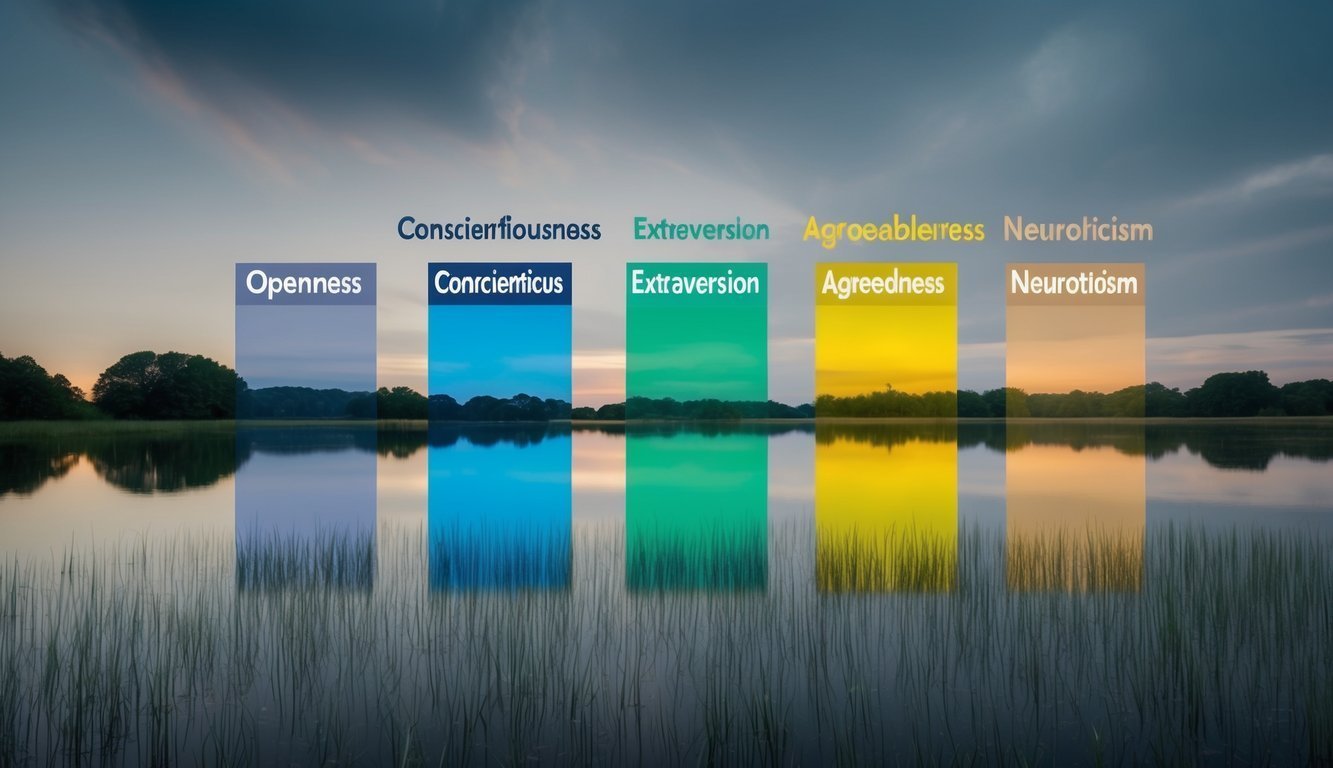PsychNewsDaily Publishers
100 Summit Drive
Burlington, MA, 01803
Telephone: (320) 349-2484
PsychNewsDaily Publishers
100 Summit Drive
Burlington, MA, 01803
Telephone: (320) 349-2484
The Five-Factor Model encompasses five dimensions: Openness, Conscientiousness, Extraversion, Agreeableness, and Neuroticism, shaping individual behavior and influencing personal and professional relationships.

The Big Five personality traits offer an extensive framework to comprehend individual differences in human behavior and characteristics. This model has established itself as a fundamental concept in personality psychology, providing valuable insights into how people think, feel, and behave.
The Big Five model originated from many years of research in personality psychology. Its foundations can be traced back to the lexical hypothesis, which suggested that significant personality traits are represented through language.
In the 1930s, researchers started to examine personality-related terms found in dictionaries, forming a basis for subsequent studies.
By the 1960s, various researchers independently discovered five consistent factors in personality assessments. These results coalesced into what is now recognized as the Five-Factor Model of personality.
The model gained substantial acceptance during the 1980s and 1990s, becoming a benchmark in personality research and evaluation.
The Five-Factor Model, commonly referred to as the Big Five or OCEAN model, includes five broad personality dimensions:
Each dimension represents a continuum, with individuals positioned at various points along the spectrum.
Openness is indicative of curiosity and creativity. Conscientiousness relates to organization and reliability. Extraversion is associated with sociability and assertiveness.
Agreeableness encompasses qualities such as empathy and cooperation. Neuroticism reflects emotional stability and levels of anxiety.
These traits interact to create distinctive personality profiles, impacting behavior, decision-making, and social relationships across different areas of life.

The Big Five personality traits cover essential elements of human behavior and character. These dimensions serve as a framework for understanding personality differences among individuals.
Extraversion denotes an inclination to seek stimulation and interact with the outside world. Extraverted individuals often exhibit high levels of sociability, assertiveness, and enthusiasm.
Key aspects of extraversion include:
Extraverts typically flourish in social environments and enjoy being the focus of attention. They are often talkative, outgoing, and comfortable in leadership positions.
Conversely, introverts tend to favor quieter settings and may feel fatigued by prolonged social interactions. They frequently excel in tasks that demand intense concentration and independent effort.
Agreeableness reflects a person’s inclination towards kindness, collaboration, and social harmony. Individuals with high agreeableness are often regarded as compassionate, understanding, and altruistic.
Key dimensions of agreeableness include:
Agreeable people typically prioritize fostering positive relationships and minimizing conflict. They are usually cooperative team members and excel in roles requiring strong interpersonal skills.
Individuals low in agreeableness may be more competitive, skeptical, and inclined to question others’ perspectives. While this may result in conflict, it can also spur innovation and critical thinking.
Conscientiousness encompasses traits of self-discipline, organization, and purpose-driven behavior. Highly conscientious individuals are usually dependable, diligent, and detail-oriented.
Key indicators of conscientiousness include:
Individuals high in conscientiousness often thrive in educational and professional environments due to their strong work ethic and capability to meet deadlines. They generally plan ahead, adhere to guidelines, and strive for excellence in their endeavors.
Those low in conscientiousness may exhibit spontaneity and flexibility, but they might struggle with organization and achieving long-term goals.
Neuroticism describes the tendency to experience negative emotions and psychological distress. Individuals scoring high in neuroticism are more likely to face anxiety, depression, and mood fluctuations.
Key indicators of neuroticism include:
People high in neuroticism may be more vulnerable to stress and worry, often experiencing strong emotional reactions to challenges.
In contrast, emotional stability—opposite to neuroticism—exemplifies resilience and the ability to remain composed under pressure. Emotionally stable individuals usually handle stress effectively and maintain a more steady emotional state.
Openness to experience signifies curiosity, imagination, and a willingness to embrace new experiences. Individuals high in openness are often creative, intellectually curious, and have an appreciation for art and aesthetics.
Key facets of openness include:
Those who score high in openness frequently enjoy lending themselves to new ideas, engaging in creative activities, and challenging conventional wisdom. They generally have diverse interests and are open to novel perspectives.
Conversely, individuals low in openness may prefer established routines and traditions, valuing practicality. While less inclined to seek novelty, they often perform well in tasks requiring focus and consistency.

Personality assessments and inventories yield crucial insights into individual differences. The Big Five traits have broad applications across personal and professional arenas.
The NEO Personality Inventory serves as a widely utilized tool for evaluating the Big Five traits, presenting a thorough assessment of an individual’s personality profile.
The Big Five Inventory offers a shorter alternative, balancing brevity with accuracy by utilizing concise statements to assess each trait.
Researchers have crafted brief measures for quick assessments, which can be advantageous for large-scale surveys or preliminary screenings.
Most personality tests employ Likert scales, inviting respondents to indicate their level of agreement with several statements. Some innovative methods also integrate facial image analysis to evaluate traits.
The Big Five traits significantly influence various aspects of life. In interpersonal relationships, they affect social interactions and partner compatibility.
In the workplace, these traits can help predict job performance and potential for leadership. For instance, conscientiousness often correlates with productivity and dependability.
Organizations may incorporate Big Five evaluations in recruitment processes, aiding in aligning candidates with roles that complement their personality strengths.
Throughout the lifespan, personality traits can exhibit gradual changes. Understanding these evolutions can enhance personal growth and adjustment to new life stages.

The Big Five personality traits significantly affect human behavior across diverse situations. These traits not only shape how individuals interact in social contexts but also influence health-related outcomes.
Personality traits have a strong impact on social behavior. Extraverted individuals usually display greater sociability and outgoingness in group scenarios, actively seeking social interactions and feeling invigorated by them.
Agreeable individuals often demonstrate greater compassion and trustworthiness in their relationships, aiming to maintain harmony and frequently being viewed as cooperative team members.
Those high in neuroticism may find themselves experiencing heightened anxiety and self-consciousness in social settings, resulting in more reserved or cautious behavior when faced with unfamiliar situations.
Openness to experience is linked to curiosity and creativity in social interactions, with such individuals enjoying intellectual discussions and exploring new ideas with others.
Conscientious individuals tend to be reliable and well-organized in their social commitments, often following through on plans and maintaining steady social connections.
The Big Five traits can have a substantial impact on physical and mental well-being. Conscientiousness is often linked to improved overall health outcomes, including reduced incidence of chronic illnesses and longer life spans.
Neuroticism is frequently connected with increased levels of anxiety and depression, making individuals high in this trait more vulnerable to stress-related health complications.
Extraversion correlates with better subjective well-being and life satisfaction, with these individuals generally reporting improved mental health outcomes and greater resilience to stressors.
Openness to experience can affect health-related behaviors, as those who score high may be more eager to try new health interventions or embrace lifestyle modifications.
Agreeableness is linked to better compliance with medical advice and treatment plans, with these individuals typically possessing stronger support networks that can positively influence their health.

Personality traits showcase both commonalities and distinctions across different cultures. Additionally, these traits evolve as people age, revealing specific patterns throughout the lifespan.
Cross-cultural investigations into personality traits highlight both universal patterns and culturally specific variations. The Big Five model has displayed consistency across numerous cultures, though its applicability can vary globally.
Certain cultures may prioritize specific traits more than others; for instance, collectivist societies might place a higher value on agreeableness and conscientiousness.
Research methods can differ across cultures, with self-report measures being more prevalent in Western nations. To enhance cross-cultural personality research, observer ratings and behavioral assessments are increasingly utilized to complement self-reports.
The HEXACO model, which integrates the dimension of Honesty-Humility alongside the Big Five, has gained popularity in some cultural settings and may address personality aspects that are not fully encapsulated by the traditional Big Five framework.
Age-related personality changes occur across all cultures. Generally, individuals tend to become more conscientious and agreeable as they grow older, while neuroticism typically decreases.
These changes don’t affect everyone uniformly, as factors such as life experiences, societal expectations, and cultural practices can shape an individual’s personality development.
In mid-adulthood, personality traits often stabilize, but major life events can still prompt changes in later years.
Moreover, research indicates that personality continues to evolve in older adulthood, which challenges the earlier perception that personality remains fixed after early adulthood.
Cross-cultural studies have identified some universal trends regarding age-related personality changes; however, the timing and extent of these changes can differ greatly across cultures.